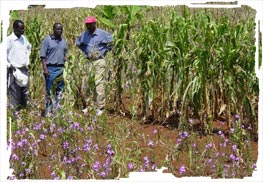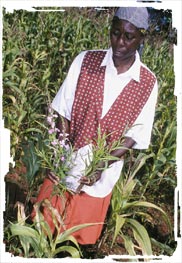Kenya
July 29, 2005
 |
|
The
striking difference between purple and green: the maize
in the foreground is overrun with Striga, but the
healthy green maize has been protected. |
In a country where
each person consumes at least 100 kilograms of maize a year, a
new, easy-to-use, affordable practice that could raise the
crop’s production by 200,000 tons is, naturally, greeted with
much celebration in Kenya.
Such was the mood
at Kisumu, Kenya, during the 5 July launch of the Clearfield®
technology for Striga weed control. “This is good news
for farmers, and good news for the government,” stated the chief
guest, Romano Kiome, director of the
Kenya Agricultural Research
Institute (KARI). If widely adopted, according to Kiome, the
technology could “…lift poor farmers from subsistence to income
generation, poverty to wealth, and food insecurity to security.”
A highly invasive
parasite, Striga infests 400,000 hectares of Kenya’s
farmland. Striga sprouts fasten directly to roots of
maize seedlings, sucking away nutrients and 50 to 100% of yields
by harvest time. The weed overruns 40% of the arable land in
Africa’s savannahs, threatening the livelihoods of more than 100
million people who depend on cereal crops for food and income.
Kenyan maize farmers lose at least US$ 50 million annually in
grain to Striga.
|
 |
|
This farmer will lose a
significant amount of her maize yield because of
Striga. |
Taking advantage
of a natural variation in maize, for nine years
CIMMYT and partners have
conventionally bred varieties that yield well under tropical
conditions and withstand imidazolinone, an active ingredient in
several herbicides and the BASF product, Strigaway®. This
imidazolinone-resistant (IR) maize is the starting point for an
elegant control method, as CIMMYT agronomist Fred Kanampiu
explains: “The IR maize seed is coated with a low dose of the
herbicide, which kills Striga as it germinates,
allowing the maize to grow clear of the weed.” Besides producing
healthy maize plants, over several years the practice helps
clear fields of residual Striga seed—a boon to farmers,
given that a single Striga plant produces up to 50,000
tiny seeds that can remain viable for 20 years or more.
Four new maize
hybrids have been released for marketing in Kenya under the
common name Ua Kayongo (literally “kill Striga”)
H1–4, and farmers are enthusiastic, as their statements in the
Nairobi Daily Nation show: “I have already seen major changes in
my farm compared to my neighbors’, whose parcels remain covered
with the purple flowers of the parasitic weed,” says Zedekiah
Onyango of Baridi farm in Nyahera. “My maize yield is many times
higher since I started using IR maize, and I look forward to
even higher yields.” Farmers are also urging the government to
promote the technology to arrest the perennial food shortages
caused by Striga. “I believe it would be much cheaper
for the government to invest money in the technology, so that
this menace is cleared once and for all, and the production of
various cereals is restored,” says Beatrice Ayoo, another
small-scale farmer who is interested in the new Clearfield®
practice.
The technology was
developed through global cooperation involving
CIMMYT; KARI; the Weizmann
Institute of Science, Israel; BASF; private seed companies; and
the Rockefeller Foundation; among others. Peter Matlon, director
for the Africa Regional Program, the Rockefeller Foundation, was
at the launch, and called the cross-sectoral collaboration “a
classic example of partnership.” The Clearfield® control package
will be released soon in Tanzania, Uganda and, eventually, 16
other countries of sub-Saharan Africa, in a process spearheaded
by the African Agricultural Technology Foundation (AATF) with
DFID support. |